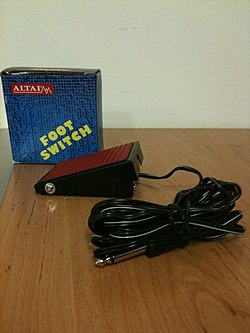Assistive Technology
Assistive technology is a collective term for devices that help improve physical or mental functions in people, whose functions are, for various reasons, reduced. The concept of assistive technology may include not only these aids themselves, but also the services associated with their provision.
Division of assistive technologies[edit | edit source]
The technical advancement of assistive technologies does not necessarily reach "space research", in addition to highly sophisticated aids replacing the function of sight, the term assistive technologies also includes a seemingly simple Velcro, which facilitates dressing.
In addition to aids of a more or less prosthetic nature, aids facilitating communication with a computer represent an extensive field of assistive technologies. Due to great importance of computer technology and especially the Internet in contemporary communication, ensuring sufficient communication with a computer is a factor that fundamentally affects the quality of life.
Assistive technologies therefore cover a very wide area, fields falling into the category may be following:
- Architectural modifications (e.g. housing adaptation)
- Sensory aids – aids facilitating perception (e.g. hearing aids, cochlear implant, glasses, artificial retina,...)
- Computer technology - specific software and hardware (e.g. reading programs, keyboards with Braille,...)
- Prostheses a orthoses
- Aids facilitating personal mobility (e.g. wheelchair)
- Modification of furniture and equipment of the apartment
- Recreation and sports aids
- Services including selection of appropriate aids and training in their use
Visual impairment and vision loss[edit | edit source]
Facilitating work with a computer[edit | edit source]
- the settings of most operating systems allow you to enlarge the text on the monitor
- software, which magnifies a part of the monitor
- software readers – programs, which convert text into spoken word
- high contrast and large dimensions of the keyboard description
- keyboard adapted for tactile orientation
- replacing the mouse function with simple keyboard shortcuts
- voice text input
- "monitors" displaying text in Braille
- recommendations for the creation of websites facilitating processing of the text by the reader
Making documents easier to read[edit | edit source]
- magnifying glass
- electronic magnifiers - unlike a magnifying glass, they display a larger area of the document on the monitor
- database of electronic documents in text form
- database of electronic documents in audio form
Hearing impairment and hearing loss[edit | edit source]
Hearing Support[edit | edit source]
Substitution of hearing with other senses[edit | edit source]
- warning devices - in the event that sufficient hearing cannot be achieved, an acoustic signal (alarm clock, doorbell, child's cry...) can be converted to another (light signals, small vibrations,...)
- simultaneous interpretation into sign language
- video phone connection
Movement disorders[edit | edit source]
Communication with the computer[edit | edit source]
- trackball, joystick
- dimensionally or ergonomically modified keyboards
- a switch controlled by the blink of an eyelid, breath or a limb movement
- keyboard based on tracking eye movement (Eyegaze)
- communication using the leg motion detection
- communication using the mouth or tongue motion detection
- voice input
Everyday life[edit | edit source]
- wheelchairs
- prosthetic devices
- electronic control of environmental elements, their normal use is made impossible or difficult due to a malfunction (e.g. opening doors)
- aids and structural modifications enabling car operation
- aids enabling or facilitating rehabilitation and exercise
Disorders of mental abilities[edit | edit source]
- document readers (in case of a disorder associated with a reduced ability to read)
- computer voice input (in case of a malfunction associated with a reduced ability to write)
- dictionaries and spell check (especially dysgraphia)
- audiovisual instructions for performing common activities (mental retardation, dementia)
Links[edit | edit source]
Literature[edit | edit source]
- ROBITAILLE, Suzane. The illustrated guide to assistive technology and devices: tools and gadgets for living independently. 1. edition. 2010. ISBN 978-1-932603-80-4.
External links[edit | edit source]
- Jaderňácká wiki. Asistivní technologie (01ASTE) [online]. [cit. 27.3.2011]. <https://wiki.fjfi.cvut.cz/wiki/Asistivn%C3%AD_technologie_%2801ASTE%29>.
- Sjednocená organizaci nevidomých a slabozrakých ČR. Blind Friendly Web [online]. [cit. 27.3.2011]. <http://blindfriendly.cz/>.
- PAVLÍČEK, Radek. Poslepu [online]. [cit. 27.3.2011]. <http://poslepu.blogspot.com/>.
- Stanford University. ENGR110/210 Perspectives in Assistive Technology [online]. [cit. 27.3.2011]. <https://web.stanford.edu/class/engr110/>.




